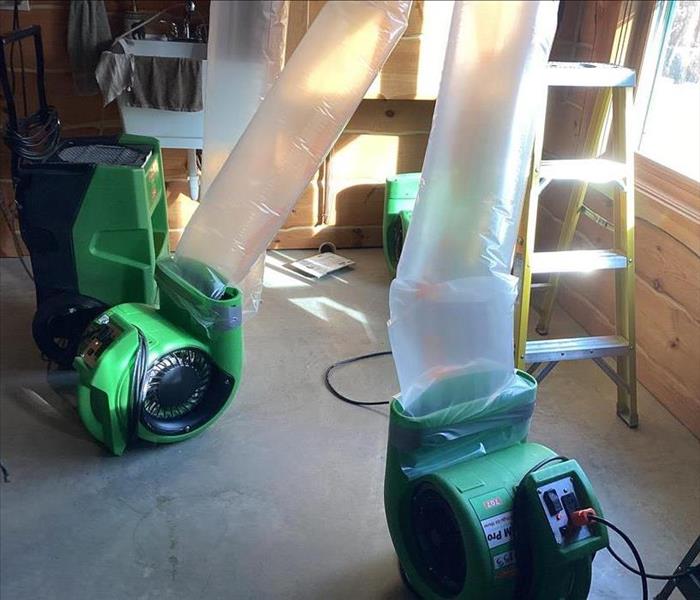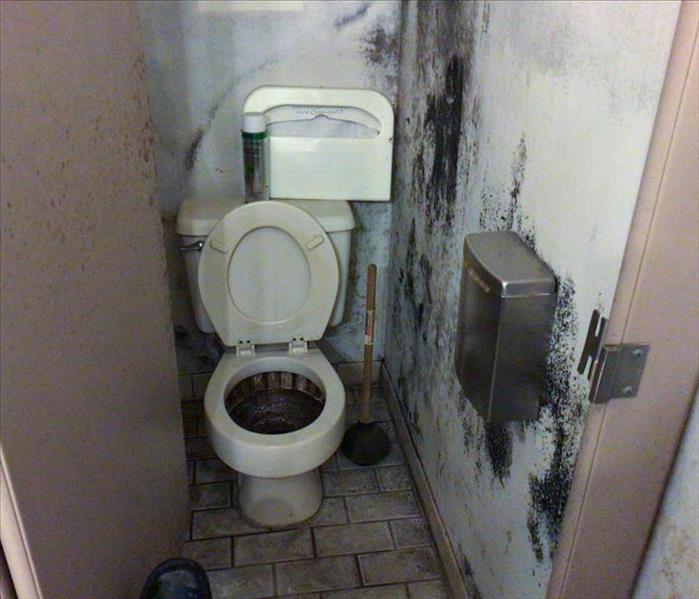Recent Mold Remediation Posts
The SERVPRO® Mold Remediation Process: Step by Step
3/13/2024 (Permalink)
 It's essential to understand the process of mold remediation and how it can effectively remove and prevent the reoccurrence of mold growth.
It's essential to understand the process of mold remediation and how it can effectively remove and prevent the reoccurrence of mold growth.
When it comes to mold damage in your home or business, it's essential to understand the process of mold remediation and how it can effectively remove and prevent the reoccurrence of mold growth. SERVPRO®, a leading provider of mold remediation services, follows a comprehensive seven-step process to ensure the thorough removal and restoration of mold-damaged areas. In this blog, we will explore the SERVPRO Mold Remediation Process step by step.
Step 1: Emergency Contact
The mold cleanup and restoration process begins with a simple phone call to SERVPRO. When you reach out to them, their representative will ask a series of questions to assess the resources, equipment, and personnel required to address your specific mold damage situation.
Step 2: Inspection and Mold Damage Assessment
Once they have gathered the necessary information, the SERVPRO team will conduct a thorough inspection of the affected area. Through advanced technologies and expertise, they can detect both visible and hidden mold growth and identify the root causes of the mold problem.
Step 3: Mold Containment
To prevent the spread of mold spores during the remediation process, the SERVPRO® team uses various containment procedures. Negative air chambers and negative air pressure are established to isolate the contaminated areas, minimizing the risk of cross-contamination.
Step 4: Air Filtration
SERVPRO® professionals employ specialized filtration equipment, including air scrubbers and HEPA vacuums, to capture microscopic mold spores from the air. By utilizing these powerful tools, prevents the further spread of mold spores throughout your property.
Step 5: Removing Mold and Mold-Infested Materials
Once the containment and air filtration systems are in place, the team starts the process of mold removal. They use antifungal and antimicrobial treatments to eliminate mold colonies and prevent new colonies from forming. In severe cases of mold damage, mold-infested porous materials like drywall and carpeting may need to be removed and properly disposed of.
Step 6: Cleaning Contents and Belongings
Mold can not only affect the structure of your property but also damage your belongings. The SERVPRO® team is trained to clean and disinfect your furniture, decorative items, clothing, and other restorable items affected by mold. They utilize a variety of cleaning techniques to ensure the removal of mold and its odors.
Step 7: Restoration
The final step in the SERVPRO Mold Remediation Process involves restoring your property to its pre-mold damage condition. Depending on the extent of the damage, this may include minor repairs like replacing drywall and painting or more significant reconstruction work. SERVPRO® is equipped to handle all aspects of the restoration process, ensuring your property is restored to its original state.
By following this comprehensive seven-step process, SERVPRO ensures that mold damage is effectively addressed and your property is restored to a clean and healthy environment. Their trained professionals use advanced techniques and equipment to remove mold, prevent its reoccurrence, and restore your property efficiently.
If you are facing mold damage in your home or business, contact SERVPRO to benefit from their expertise in mold remediation. Through their meticulous process, they will effectively fix mold damage and help you regain a safe and healthy living or working environment.
Remember, it's important to address mold damage promptly and seek professional assistance to ensure it is properly handled. Let SERVPRO take care of your mold remediation needs and restore your property "Like it never even happened."
Professional vs. DIY Mold Removal
11/9/2023 (Permalink)
 DIY projects can be satisfying, and they can save you money. However, mold removal is not always as straightforward as it may seem.
DIY projects can be satisfying, and they can save you money. However, mold removal is not always as straightforward as it may seem.
Homeowners here in La Crosse, WI, often face mold challenges due to our climate and environmental factors. While many people opt for DIY mold removal, it's essential to know when it's time to call in the professionals. In this blog, we'll help you make an informed decision about tackling mold issues in your home.
The Attraction of DIY Mold Removal
Mold removal is a common concern for homeowners in La Crosse, WI. Many people are tempted by the idea of handling it themselves. DIY projects can be satisfying, and they can save you money. However, mold removal is not always as straightforward as it may seem.
When DIY Mold Removal Works
For minor mold problems in small, non-porous areas, DIY solutions can be effective. Here are some situations where DIY mold removal may suffice:
- Surface Mold on Non-Porous Materials: If you discover mold growth on easy-to-clean, non-porous surfaces like tiles or glass, you can often remove it with commercial mold cleaners.
- Limited Mold Growth: If the affected area is small (less than 10 square feet) and the mold growth is superficial, DIY removal can be appropriate.
When to Call the Professionals
While DIY solutions have their place, there are circumstances where professional mold remediation becomes crucial:
- Extensive Mold Growth: When mold covers a large area, spreads through hidden spaces, or infiltrates building materials, it's time to call in the experts.
- Hidden Mold: Mold often lurks in hidden spaces, such as within walls, under flooring, or in HVAC systems. Professionals have the tools and expertise to locate and remove it.
- Recurring Mold Problems: If you've previously attempted DIY mold removal, and the mold keeps coming back, it's a sign of an underlying issue that professionals can identify and address.
The Benefits of Professional Mold Remediation
Professional mold remediation offers several advantages:
- Thoroughness: Professionals conduct comprehensive inspections and address the root causes of mold growth.
- Safety: They have the necessary protective gear and follow industry best practices to ensure safety.
- Expertise: Professionals are trained and experienced in handling mold removal effectively.
- Prevention: They can advise on preventive measures to reduce the likelihood of future mold issues.
Protecting Your Clothes, Belongings, and Furniture
In addition to the potential structural damage, mold can also wreak havoc on your personal belongings, including clothes and furniture. Mold spores can settle on fabrics, leather, wood, and upholstery, leading to unsightly stains, musty odors, and deterioration. Dealing with mold on your clothes, cherished belongings, or furniture can be challenging, as it often requires more specialized cleaning techniques than simple surface mold removal. When mold extends its reach to your personal items, it becomes even more vital to consider professional mold remediation to ensure the thorough and safe removal of mold from your living space.
While DIY mold removal can be suitable for minor issues, it's essential to recognize when it's time to bring in the professionals. In La Crosse, WI, where mold problems can be persistent, turning to experts like SERVPRO® of La Crosse County ensures a thorough, safe, and effective solution. Don't hesitate to contact us when you need professional mold remediation assistance. We're here to help you protect your home from mold-related challenges.
Restoring Your Content After a Mold Loss: A Comprehensive Guide
5/23/2023 (Permalink)
 Restoring content after a mold loss can be a challenging and time-consuming process.
Restoring content after a mold loss can be a challenging and time-consuming process.
Mold is a common problem in many households, and it can cause extensive damage to your belongings, including furniture, clothing, and sentimental items. Dealing with a mold loss can be overwhelming, but with the right knowledge and approach, you can restore your content and minimize your losses. In this comprehensive guide, we will provide you with valuable information and practical tips on how to restore your content after a mold loss.
Safety First: Mold Remediation
Before you start restoring your content, it's crucial to prioritize safety. Mold can pose serious risks, and it's essential to take proper precautions to protect yourself and others. If the mold loss is extensive or if you have any concerns, it's best to hire a professional mold remediation company to assess the situation and handle the cleanup process.
Assessing the Damage
Once the mold has been remediated, it's time to assess the damage to your content. Take an inventory of all the items that have been affected by mold and determine the extent of the damage. Some items may be salvageable with proper cleaning and restoration techniques, while others may need to be discarded if the damage is too severe.
Sorting and Prioritizing
Sorting and prioritizing your content is a crucial step in the restoration process. Start by categorizing your items into three categories: salvageable, questionable, and unsalvageable. Salvageable items are those that can be cleaned and restored to their pre-mold condition, questionable items are those that may require additional assessment or testing, and unsalvageable items are those that are beyond repair and need to be discarded.
Prioritize the restoration process based on the value and sentimental importance of each item. Items with sentimental value such as family heirlooms or irreplaceable photographs may be worth investing more time and effort into restoring, while items of lesser importance may be lower on your priority list.
Cleaning and Restoration Techniques
The cleaning and restoration techniques you use will depend on the type of content that has been affected by mold. Here are some common content categories and the recommended restoration techniques:
Furniture: For moldy furniture, start by vacuuming the surface with a HEPA filter vacuum to remove loose mold spores. Then, clean the furniture with a mild detergent solution or a commercial mold cleaner, following the manufacturer's instructions. If the furniture is made of porous materials such as fabric or wood, it may need to be professionally cleaned or refinished.
Clothing: Moldy clothing can usually be cleaned by washing them with a mild detergent and warm water. For delicate or valuable clothing, it's best to consult with a professional cleaner.
Electronics: Mold can damage electronics, and it's crucial to handle them with care. If your electronics have been affected by mold, do not turn them on, as it can cause further damage. Instead, unplug them and wipe the surface with a cloth dampened with isopropyl alcohol or a commercial electronics cleaner. If the mold has penetrated the internal components, it's best to consult with a professional electronics technician for restoration.
Documents and Books: Moldy documents and books should be handled with care to prevent further damage. If the pages are still wet, carefully separate them and lay them flat to dry in a well-ventilated area. Once they are dry, you can gently brush off any loose mold with a soft brush or cloth. If the documents or books are valuable or have sentimental value, it's best to consult with a professional document restoration service for further cleaning and restoration techniques.
Artwork and Decorations: Moldy artwork and decorations may require special care depending on the type of material they are made of. For paintings, you may need to consult with a professional art restorer for proper cleaning and restoration techniques. For other decorations such as ceramic or glass items, they can typically be cleaned with a mild detergent solution or a commercial mold cleaner.
Restoring content after a mold loss can be a challenging and time-consuming process. If you are unsure about the restoration techniques or if you have valuable or sentimental items that require special care, it's best to seek professional help, such as our SERVPRO of La Crosse County team. Our technicians have the expertise and equipment necessary to properly restore your content and ensure that it is safe to use or display again.






 24/7 Emergency Service
24/7 Emergency Service

